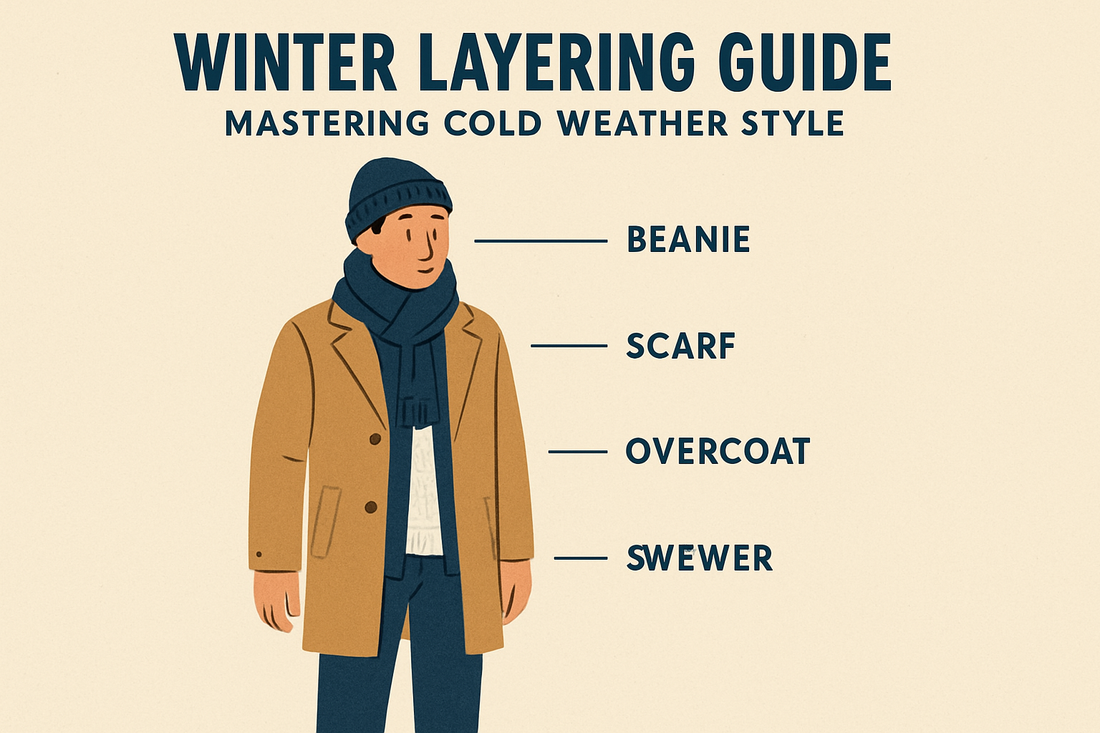
Winter Layering Guide: Mastering Cold Weather Style
Share
Understanding the Fundamentals of Winter Layering
Winter layering transcends mere clothing accumulation—it's an artful orchestration of fabrics, textures, and silhouettes that creates both thermal efficiency and sartorial sophistication. The stratification system operates on three fundamental tiers: the moisture-wicking base layer, the insulating middle layer, and the weather-resistant outer shell. This triumvirate approach ensures optimal thermoregulation while maintaining aesthetic coherence.
Mastering this technique requires understanding fabric properties and their synergistic interactions. Natural fibers like merino wool excel in base layers due to their hygroscopic qualities, while synthetic insulators provide superior loft-to-weight ratios in intermediate layers. The outer shell must balance breathability with weather protection, creating a microclimate that adapts to fluctuating conditions.
The Science Behind Effective Layering
Thermal regulation operates through trapped air pockets between layers, creating insulative barriers that prevent heat dissipation. This phenomenon, known as loft, becomes compromised when layers are too tight or constructed from non-compatible materials. Understanding the convective, conductive, and evaporative heat transfer mechanisms allows for strategic layer selection that maximizes warmth retention while preventing moisture accumulation.
Building Your Foundation Layer System
The foundational stratum serves as your skin's protective interface, managing perspiration and maintaining optimal body temperature. Premium base layers feature moisture-wicking capabilities through capillary action, drawing sweat away from the epidermis and facilitating rapid evaporation. Merino wool stands as the quintessential choice, offering natural antimicrobial properties and temperature regulation across varying activity levels.
Synthetic alternatives like polyester blends provide durability and quick-drying characteristics, though they may retain odors more readily than natural fibers. The fit should be snug but not restrictive, allowing for unrestricted movement while maintaining contact with the skin for optimal moisture transfer. Seamless construction minimizes chafing during extended wear periods.
Choosing the Right Fabric Technologies
Advanced textile innovations have revolutionized base layer performance. Phase-change materials (PCMs) absorb and release thermal energy as temperatures fluctuate, while silver-infused fibers provide lasting odor resistance. Flat-seam construction eliminates pressure points, and thumb loops ensure sleeve positioning remains consistent throughout the day.
Mastering Insulation Layers for Maximum Warmth
The insulative stratum represents the thermal engine of your layering system, trapping warm air while facilitating moisture vapor transmission. Down insulation offers unparalleled warmth-to-weight ratios, with fill power ratings indicating loft quality. However, synthetic alternatives maintain insulative properties when wet and dry more rapidly, making them superior for high-moisture environments.
HTO Apparel's coats collection exemplifies versatile insulation options designed for contemporary winter styling. This curated selection features various insulation technologies and silhouettes, from minimalist puffers to statement wool blends, ensuring you'll discover the perfect intermediary layer for any cold-weather scenario.
Layering thickness should correlate with anticipated activity levels and external conditions. Sedentary pursuits require maximum loft, while dynamic activities benefit from breathable, less bulky options that prevent overheating during exertion peaks.
Strategic Insulation Placement
Core temperature maintenance takes precedence over extremity warmth, making torso insulation paramount. However, strategic insulation distribution across shoulders, arms, and lower back creates comprehensive thermal coverage. Articulated designs accommodate natural body movement without compromising insulative integrity.
Selecting the Perfect Outer Shell
Your protective carapace must harmonize weather resistance with vapor permeability, creating a selective barrier that repels external moisture while allowing internal humidity to escape. Waterproof-breathable membranes achieve this balance through microporous structures that block liquid water while permitting vapor molecules to pass through.
The Pleather Puffer Jacket with Removable Hood represents an innovative approach to outer shell versatility. Its vegan leather construction provides wind resistance and contemporary aesthetic appeal, while the removable hood adapts to changing weather conditions and style preferences. This piece seamlessly transitions from casual weekend wear to elevated urban ensembles, embodying the multifunctional ethos essential for modern winter wardrobes.
Shell selection should account for anticipated weather patterns and activity requirements. Urban environments may prioritize style and moderate weather protection, while outdoor pursuits demand maximum technical performance and durability.
Breathability vs. Weather Protection Trade-offs
The eternal compromise between complete weather sealing and vapor transmission requires careful consideration of use cases. Highly breathable shells excel during active pursuits but may compromise protection during severe weather events. Conversely, completely waterproof shells provide maximum protection but can create internal condensation during vigorous activities.
Stylish Color Coordination and Pattern Mixing
Chromatic harmony in layering requires understanding undertones and complementary palettes that enhance rather than compete with each other. Neutral foundations provide versatility for accent colors, while monochromatic schemes create sophisticated depth through textural variation. The 60-30-10 color rule applies to layering: dominant neutral, supporting secondary tone, and accent color for visual interest.
Pattern integration demands careful scale consideration. Combining different pattern sizes prevents visual chaos—pair large-scale prints with micro-patterns or solids. Textural contrast can substitute for pattern variation, creating visual interest through material juxtaposition rather than graphic elements.
"The key to successful winter layering lies not in the quantity of pieces, but in the strategic selection of complementary elements that work in harmony to create both function and beauty."
Creating Visual Interest Through Texture
Tactile variety elevates simple color palettes through material contrast. Smooth leather against chunky knits, sleek synthetics paired with natural wool textures, or structured outerwear over flowing fabrics create dimensional appeal that transcends chromatic limitations.
Essential Layering Pieces for Every Wardrobe
A comprehensive winter layering arsenal requires strategic investment in versatile foundational pieces that interchange seamlessly across various styling scenarios. Essential elements include moisture-wicking base layers in neutral tones, insulating cardigans or lightweight sweaters, structured blazers for professional settings, and statement outerwear that reflects personal aesthetic preferences.
- Merino wool or synthetic base layers in black, white, and nude tones
- Lightweight cashmere or wool sweaters for insulation
- Structured blazers that accommodate layering underneath
- Versatile cardigans in complementary colors
- Statement coats that serve as outfit focal points
- Transitional pieces like vest layers for temperature flexibility
Investment priorities should focus on quality over quantity, selecting pieces constructed from premium materials with timeless silhouettes that transcend seasonal trends while maintaining contemporary relevance.
Common Layering Mistakes to Avoid
Successful winter layering requires avoiding pitfalls that compromise both comfort and aesthetics. Over-layering creates bulk without proportional warmth increases, while inappropriate fabric combinations can trap moisture and reduce thermal efficiency. Fit inconsistencies—such as tight base layers under loose outer shells—disrupt the insulative air pocket system.
Color clashing occurs when undertones compete rather than complement each other. Additionally, neglecting proportion balance creates unflattering silhouettes that overwhelm the wearer's natural shape. Strategic layering enhances rather than obscures your natural proportions.
| Common Mistake | Consequence | Solution |
|---|---|---|
| Too many layers | Restricted movement, overheating | Choose fewer, higher-quality pieces |
| Poor fit progression | Bunching, discomfort | Size up progressively for each layer |
| Incompatible fabrics | Moisture retention, reduced warmth | Research fabric compatibility |
Proportion and Silhouette Considerations
Maintaining flattering proportions requires balancing volume distribution across your frame. If your outer layer adds significant bulk to your upper body, consider streamlined lower layers and fitted bottoms to maintain visual equilibrium. Conversely, structured outer shells can accommodate more relaxed underlayers without compromising silhouette integrity.
Frequently Asked Questions
How many layers should I wear in freezing temperatures?
Three layers typically suffice: base layer, insulating layer, and outer shell. Additional layers may be necessary for extreme conditions, but focus on quality insulation rather than quantity.
Can I layer different fabric types together?
Yes, but ensure compatibility. Natural fibers pair well with other natural materials, while synthetics work effectively with both natural and synthetic combinations. Avoid cotton against the skin in cold conditions.
How do I prevent looking bulky while staying warm?
Choose fitted base layers, structured outer shells, and strategic volume placement. Invest in high-quality insulation that provides maximum warmth with minimal bulk, and ensure proper fit progression through each layer.
What's the best way to transition layers throughout the day?
Select easily removable pieces like cardigans, scarves, or zip-up layers. Vest options provide core warmth without sleeve bulk, making them ideal for temperature fluctuations in indoor/outdoor environments.


